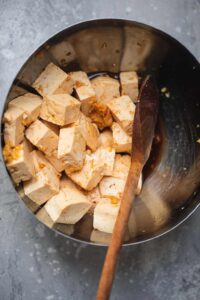A ubiquitous staple in Japanese and Chinese cookery, miso, or fermented soybean paste, is a powerhouse of concentrated flavor and nutrition. Three types of miso are commonly available in the Western natural-food market: soybean miso, rice miso, and barley miso (rice and barley misos actually combine soybeans with the grain). Within each category of miso exists a range of earthy hues and subtle flavor variations, all more or less in the realm of a pungent saltiness. The texture resembles that of peanut butter. Miso is best known as the base for simple, broth-type soups, although it is equally useful as a basis for sauces, dressings, and dips.
Miso is commonly sold in either plastic packages or tubs. Once the tubs are opened, it is best to reseal them tightly and refrigerate. Once the plastic packages are opened, they should be additionally protected by placing them in another container, such as a tightly lidded glass jar or plastic container. Refrigerated miso keeps very well for several months. After some time, a white mold may develop around the edges. Although this may be scraped off and the rest of the miso used, it is your signal that the freshness is waning. Here are some recipes using miso you can link to here on VegKitchen:
- Miso-Butternut Squash Soup
- Miso Soup with Winter Vegetables
- Shiitake-Miso Gravy
- Udon Noodles with Spinach-Miso Pesto
- Nasu Dengaku (Japanese Eggplants Broiled with Miso)
- Dilled Miso-Tahini Dip
Miso has been produced in the Orient for several centuries, and the methods used today are a little different from the ancient ones. The important first step in making miso is to prepare the mold culture, called koji, which will ferment the soybeans or the soy and grain combination, depending on what type of miso is being made. For soybean-only miso, cooked soybeans rest for 2 to 3 days in a special room, called the koji-room, during which a mold is called Aspergillus hatcho develops on them. For soybean and rice miso or soybean and barley miso, cooked grain is similarly put in a koji-room, and a mold called Aspergillus orizae grows on either grain.
To make soybean miso, or, as it is commonly called, hatcho miso, the soy koji is combined with cooked soybeans, salt and water. To make rice or barley miso, the grain koji is combined with cooked soybeans, cooked rice or barley, salt, and water. These ingredients are then stored in large cedar kegs. The mold cultures release beneficial enzymes that stimulate the fermentation process. These enzymes assist in breaking down the starches in the soybeans and grains into simple sugars and cause the protein to be broken down into separate amino acids. Miso is aged for periods of 1 to 3 years, depending on the type that is being made. The length of time, the temperature at which the fermentation process takes place, and the proportions of the ingredients used all contribute to the final result and are responsible for the differences between the various types of miso. Miso packaged for exportation is required to be pasteurized as an extra safety measure.
“Quick” misos are not uncommon and, predictably, are a modern innovation. Through temperature control, the fermentation process can be speeded up to completion within a few weeks. Often, flavorings, additives, and preservatives are added to quick misos, and they don’t taste as fine and complex as traditionally aged misos. There is no real advantage to buying quick miso. If in doubt as to what you are getting, read the ingredients— natural, aged miso contains only soybeans (and grain, in the case of rice or barley miso), salt, and water.
The protein content of miso ranges from about 13 percent in rice miso and about 18 percent in barley miso to about 20 percent in soybean miso. One tablespoon of miso provides an average of 2.5 grams and protein and contains only 27 calories. All misos are excellent sources of iron, calcium, phosphorus, and the B vitamin range, including vitamin B12, which is rarely found in vegetable sources. Fermentation makes miso very easily digestible, and the live lactic-acid bacteria and enzymes that it contains aid in general digestion.
Miso serves as a substitute for both salt and soy sauce in that you would be unlikely to use them in tandem in any given dish; even the sweetest rice misos are salty (miso contains an average of 12 percent salt, which acts a preservative, preventing harmful bacterial growth). The concentrated flavor of miso goes a long way; rarely will you see more than 2 or 3 tablespoons called for in a recipe that serves 4 to 6. Miso is easier to use if it is diluted in a small amount of warm water and stirred until smooth. When cooking with miso, do not boil it, because it destroys the beneficial enzymes.
The essential differences between soybean, barley, and rice misos are outlined below and followed by some basic ways in which to use miso in general.
SOYBEAN (HATCHO) MISO
Hatcho miso is named for the Chinese city of the same name, where it originated. The darkest, firmest, most intensely flavored of misos, hatcho resembles a thick chocolate fudge. Its fermentation process is a long one, optimally between 2 and 3 years. Because its flavor is exceptionally strong, soybean miso is often mixed with other misos.
Made with soybeans, soybean koji, salt, and water, hatcho miso has the highest protein content among misos at about 20 percent, as well as the highest fat content at about 10 percent. It is richest in calcium, phosphorus, and iron and is comparable to the other misos in its content of the B-complex vitamins.
The robust flavor of hatcho makes it a favorite winter miso, most appropriate for use with cold-weather foods such as root vegetables and in hearty dishes such as stews. If you enjoy the strong flavor of this miso, however, you need not adhere to this rule religiously.
BARLEY (MUGI) MISO
Barley, or mugi, miso is made by mixing barley, soybeans, barley koji, salt, and water. The fermentation period is shorter than for soybean miso, the optimal time being between 18 months and 2 years. Barley miso has become the most widely accepted by Westerners and is also very popular in Japan. Its not-too-sweet, not-too-overpowering flavor makes it appropriate for both summer and winter use. It is an ideal base for almost all miso soups, sauces, and spreads. In Japan, mugi miso is considered a “country-style” food; it is available in smooth and chunky textures.
RICE MISO
Rice miso is made from a combination of rice, soybeans, rice koji, salt, and water. This type of miso has the shortest fermentation period, since the starches in the rice are rapidly converted to sugars. Rice miso tends to have a somewhat sweet flavor, which mellows that salty taste. It is considered most appropriate for summer cooking since it is the lightest in flavor.
Several varieties of rice miso are marketed through natural-food outlets, with colors ranging from brown to red to creamy white.
The most common of there is kome miso (also known as sendai, or red miso), made from white rice. This miso is quite popular in Japan, where it has been made, using a time-honored formula, since the seventeenth century. A recent innovation is genmai miso, made from brown rice instead of white. Unpolished rice was once considered too resistant to fermentation, but a method was developed that resulted in genmai miso, which has proven to be very pleasing to the Western palate. Shiro miso is a variety of the very mild, white sweet misos, which age relatively quickly. Shiro miso uses sweet rice and less salt. Another variation on this is a product made in North America that is labeled a “mellow white miso.” These white misos are the lightest in flavor and so are ideal for using in nontraditional ways, such as blending into salad dressings, where they'll add zest but never overpower.
- For lots more features on healthy lifestyle, please explore VegKitchen’s Healthy Vegan Kitchen page.
- Here are more of VegKitchen’s Natural Food Guides.






Nellie says
I live in Richmond, IN. I would like to know where I can buy Miso. Thank You
Nava says
Nellie, you can get miso at any natural foods store. If you don't have one near you, look online. Miso Master is one of the common brands.
Nancy says
Homemade Salad dressing that has miso in it, does the dressing have to be refrigerated after making it with the miso?
Nava says
Nancy, it would be a good idea to refrigerate the unused portion of any dressing.
Rashida says
Can I use miso to make a sauce for pizza?
Nava says
Hi Rashida — tastewise, miso is good as a sauce for pizza, but my guess is that exposing it to the kind of high heat involved with baking pizza, some of the valuable enzymes in it will be compromised. Here's a pizza recipe that uses a spinach-miso pesto instead of tomato sauce: http://www.vegkitchen.com/recipes/verdant-veggie-pesto-pizza/
Kerri Pidding says
Can I spread miso thinly on bread instead of using it in soups and sauces?
Nava says
You sure can, as long as you're OK with the saltiness of having it straight!
Esther says
You wrote that misos made commercially are pasteurized, which means that they are heated to high temperatures to kill bacteria. Pasteurization doesn't differentiate between good and bad bacterias. So I'm unclear how heating miso again as you advised not to do would change any properties in the already pasteurized product? And you wrote about he beneficial enzymes and live lacto-bacteria, doesn't that get killed in the pasteurization process as well? Thanks for your clarification
Catalina says
Esther, it is true that pasteurization doesn't differentiate btween good and bad microorganisms, but it doesn't denature proteins (enzymes). In the other hand, good bacteria can be added post pasteurization to keep the beneficial properties they bring to foods, in a controled environment and free of health threatening bacteria.
Katie says
This is a small aside, but my regional pride demands it, lol.
You said Hatcho miso is named for the Chinese city where it originates. This isn't true--'Hatcho miso' literally translates to '8th Street Miso'; the two companies that make Hatcho Miso have been on that street in Okazaki, Japan for centuries. Maruya is smaller, but older and more famous within Japan for being the 'purveyor to the Shogun and Emperor', while Kakukyu is larger and has greater international distribution; both companies still produce miso the same way they have for hundreds of years, with minimal mechanization in the process, and both companies distribute internationally since the 1970's.
Other soybean-only misos popular in central Japan are called 'red miso' ('akamiso'/'akadashi miso') or 'soy miso' ('mamemiso'), in contrast to 'white miso' ('shiromiso'), which is saltier and more popular in other regions. But true Hatcho miso is an Okazaki specialty, and we're very proud of it here in Aichi prefecture.